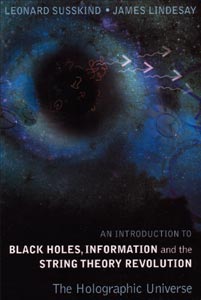by Leonard Susskind and James Lindesay, World Scientific. Hardback ISBN 9812560831, £17 ($28). Paperback ISBN 9812561315, £9 ($14).
Black holes have attracted the imagination of the public and of professional astronomers for quite some time. The astrophysical phenomena associated with them are truly spectacular. They seem to be ubiquitous in the centre of galaxies, and they are believed to be the power engines behind quasars. There is little doubt of their existence as astronomical objects, but this very existence poses deep and unresolved paradoxes in the context of quantum mechanics when one tries to understand the quantum properties of the gravitational field.

For many readers, the title of this book may sound odd because the contents have little to do with the astrophysical or observational properties of black holes. If you look for nice pictures of galaxy centres and gamma-ray bursts, you will find none. If, however, you are looking for the deep paradoxes in our understanding of quantum-field theory in nontrivial gravitational environments, and the riddles encountered when trying to harness the gravitational force within the quantum framework, then you will find plenty.
At the end of the 19th century, Max Planck was confronted with serious paradoxes and apparent contradictions between statistical thermodynamics and Maxwell’s electromagnetic theory. The resolution of the puzzle brought the quantum revolution. When Albert Einstein asked himself what someone would observe when travelling at the same speed as a light beam, the answer revealed a fundamental contradiction between Newtonian mechanics and electromagnetic theory.
The resolution of these problems led to the relativity revolution, first with special and then general relativity. Sometimes experiment itself is not the only way towards progress in our understanding of nature. Conceptual paradoxes often provide the way to a deeper view of the world.
In the 1960s, largely due to Roger Penrose and Steven Hawking, it became understood that under very general conditions, very massive objects would undergo gravitational collapse. The end state would be a singularity of infinite curvature in space-time shrouded by an event horizon – the last light surface that did not manage to leave the region. The horizon is a profoundly non-local property of a black hole that cannot be detected by local measurements of an unaware, infalling observer.
Classically, black holes were supposed to be black. However, in the early 1970s Jacob Bekenstein and Hawking showed that black holes must necessarily have very unsettling properties. As Bekenstein argued, if the second law of thermodynamics is supposed to hold, then an intrinsic entropy must be assigned to a black hole. Since entropy measures the logarithm of the number of available states for a given equilibrium state, it is logical to ask what these states are and where they came from.The entropy in this case is proportional to the area of the black-hole horizon measured in Planck units (a Planck unit of length is 10-33 cm). This is vastly different from the behaviour of ordinary quantum-field theoretic systems.
Meanwhile, Hawking showed that if one considers the presence of a black hole in the context of quantum-field theory, it radiates thermally with a temperature inversely proportional to its mass, so the hole is not black after all. If the radiation is truly thermal, this raises a fundamental paradox, as Hawking realized. Imagine that we generate a gravitational collapse from an initial state that is a pure state quantum-mechanically. Since thermal radiation cannot encode quantum correlations, once the black hole fully evaporates it carries with it all the subtle correlations contained in a pure quantum state. Hence the very process of evaporation leads to the loss of quantum coherence and unitary time evolution, two basic features of quantum-mechanical laws.
These puzzles were formulated nearly 30 years ago and they still haunt the theory community. It was, nevertheless, realized that resolving these puzzles requires deep changes in our understanding of both quantum mechanics and general relativity, and also a profound modification of the sacrosanct principle of locality in quantum-field theory.
This book is precisely dedicated to explaining what we have learned about these puzzles and their proposed solutions. Assuming that some of the basic features of quantum mechanics (such as unitary evolution) and general relativity (such as the consistency of different observers’ observations, no matter how different they may be) do indeed hold, the authors analyse the conceptual changes that are required to accommodate strange phenomena such as black-hole evaporation.
In the process, they masterfully present a whole host of subjects including quantum-field theory in curved spaces; the Unruh effect and states; the Rindler vacua; the black-hole complementarity principle; holography; the Maldacena conjecture and the role of string theory in the whole affair; the notion of information in quantum systems; the no-cloning theorem for quantum states; and the general concept of entropy bounds.
A remarkable feature of this book is that relatively little specialized knowledge is required from the reader; a cursory acquaintance with quantum mechanics and relativity is sufficient. This is impressive, given that the authors cover some of the hottest topics in current research.
The technical demands are low, but conceptually the book is truly challenging. It makes us think about many ideas we take for granted and shakes the foundations of our understanding of basic physics. It provides a rollercoaster ride into the treacherous and largely uncharted land of quantum gravity. This book is highly recommended for those interested in these fascinating topics.
The authors end with the sentence: “At the time of the writing of this book there are no good ideas about the quantum world behind the horizon. Nor for that matter is there any good idea of how to connect the new paradigm of quantum gravity to cosmology. Hopefully our next book will have more to say about this.” We hope so too.





